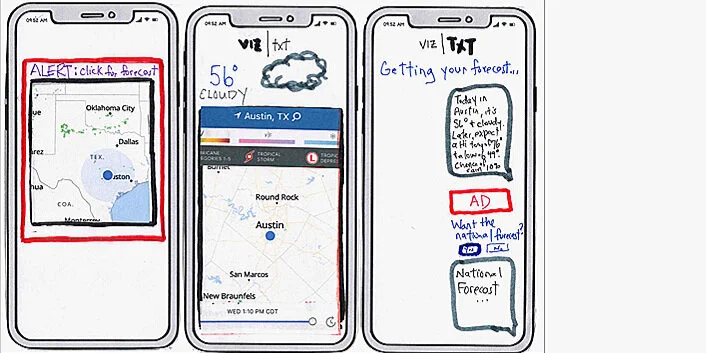
Future proofing an internet giant
With conversational interfaces on the rise, I led the charge to generate concepts and help define the future of weather. Here are just some of the concepts I generated
Take it to the app.
What is Alexa but a chatbot with a voice interface? I directed our teams to architect to deliver a conversational experience across multiple voice platforms and through chat. These concepts give The Weather Channel (TWC) as a brand the option to audio-ize alerts, incorporate national weather stories into a user’s routines, and offer chat. Thus, deepening a user’s engagement and get the weather how they want to get it
Monetization
“It’s 64 degrees where you are & YOU GET A CAR!” (j/k 🤪) But… Useing celebrity and other branded voices can make getting the weather fun and provide ‘ad’ revenue.
Voice Takeovers
The technology exists to create believable, ethically sound, doubles of human voices for commercial purposes. Companies like VocalID and Resemble.ai have used AI to prove it can happen. It’s doable today and gives users delight while allowing voice teams to pay back the business for the investment in the technology.
The user doesn’t care how it gets done. So, broker a B2B2C experience that solves a user need.
Machine Talk
The voice platforms allow some app-to-app conversation. Behind the scenes, it’s about relationships and co-engineering and co-designing experiences through API integrations and shared data. TWC does big business today using this model and I think other brands can too.
Simple to executes. Users love a deal. And, it’s trackable in most ecommerce platforms.
Promo codes
Who doesn’t love a deal? Promo codes give users access to savings on things they might want, and they give all parties involved in a test access to data need to verify an experiment. Simple to implement, simple to execute. Try it here!
The Weekend
Everyone loves time off and weekends are the among the things working people look forward to. Existing conversational interfaces do this horribly. It’s okay if there’s a screen to read out a day-by-day weather report, but, without a visual, it’s tedious. Other solutions are way to general and risk leaving out important information. Making it worse? I’m not sure users always ask specific enough questions to get weather for specific time or day. So, here are some concepts I created to solve the delivery issue and guide users to ask more specific questions.
☀️☀️☀️
If all three days on a weekend are the same (i.e. all sunny or all rainy), it’s easy to summarize and give the user what they need to plan ahead for their time off. While I don’t love this implementation, this was the only scenario where temperatures made sense. But, temperatures can vary a lot in a 3 day period. Information density is never an easy problem to solve.
☀️☀️⛈
It starts to get even trickier if two of the three days are the same, but the third is different. It could really wreck someone’s weekend plans if the message is too general and doesn’t let them know if the weather’s bad on the day they wanted to do something.
☀️⛈❄️
It gets really, really hard when all three days have either different weather conditions (i.e. rain, sun, snow) and big temperature swings. We see this all the time in spring and fall. So, I came with a way to tell users it’s a mixed bag, focus on weather condition, and tell the users how to refine the question.
Use all of that screen!
Especially when it might be 80 inches (>200 cm)!! And, most OTT systems offer voice control Heck, to compete up with Xfinity, AT&T is even marketing it’s streaming device by showing how easy it is to use voice to find something to watch. But what about publishers and other content providers?




